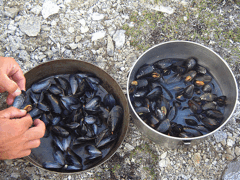Acid in the Arctic
Air Date: Week of October 9, 2009

Walrus at Kvitoya in the Svalbard archipelago (Photo: Richard Mcmanus http://www.flickr.com/photos/22918294@N04/2725875168/in/set-72157622499318628/.)
Arctic waters are rapidly turning acidic, even faster than originally thought. New research from oceanographer Dr. James Orr of the Laboratory for the Sciences of Climate and Environment in Paris predicts that the Arctic Ocean will be corrosive enough to dissolve shells of clams, mussels and others within the next decade. Host Jeff Young talks with Dr. Orr about the mounting crisis in the Arctic Ocean.
Transcript
YOUNG: As we heard, ocean acidification is one of the looming threats marine scientists are racing to better understand. As seawater absorbs carbon dioxide, it changes the pH. And recent research indicates this acidification could come fastest in the Arctic Ocean. Oceanographer James Orr is with LSCE, the Lab for Sciences of Climate and the Environment in Paris. Dr. Orr, what’s happening in the arctic waters?
ORR: The Arctic is a special case because basically, it’s cold, and, therefore, naturally more prone to acidification. So, CO2 is a gas, and like all gases, it’s more soluble in cold water. It’s not just the temperature. What sets off the Arctic from other areas is fresh water input due to river runoff, and the sea ice melting also has an impact, and actually aggravates the situation and makes it worse still.
YOUNG: So, you’ve done some work looking at what might happen in the pretty near future to the Arctic. What have you learned?
ORR: Within ten years, it’s expected that maybe ten percent of the Arctic Ocean could become corrosive to shells and mussels and clams. You hardly even need a model, you can just look at basic fundamental chemistry and the waters actually will dissolve aragonite, which an important form of shell material. That’s ten percent within ten years, and, as time goes on, as CO2 continues to increase, then it gets worse. At the end of the century, virtually all of the Arctic Ocean, as well as much of the southern ocean around Antarctica has become corrosive to this aragonite material.
YOUNG: Again, that’s the material that the animals depend on to build shells.

Arctic Mussels (Photo: http://www.flickr.com/photos/14636217@N00/243384793/)
ORR: Exactly, it’s a shell-forming material.
YOUNG: How does that compare to earlier projections on the rate of ocean acidification?
ORR: Well, the thing is not many people have looked at the Arctic. And also, you have to say that ocean acidification as a research area is really just in its infancy. It’s only about five years ago that many scientists started looking at this in earnest.
YOUNG: And what are the implications if within ten years we have some portion of the Arctic Ocean so acidic that it’s actually corrosive to marine organisms that form shells?
ORR: Well, that’s a really good question. We don’t know exactly what will happen to marine organisms. Just as a purely chemical, chemist’s viewpoint, we could say that the material will dissolve. But some of these organisms, such as the mollusks, the bivalves that are living on the bottom of the Arctic ocean are a very important food source for some mammals like walruses – they can eat 100 pounds of clams in a day, no problem.

Walrus at Kvitoya in the Svalbard archipelago (Photo: Richard Mcmanus http://www.flickr.com/photos/22918294@N04/2725875168/in/set-72157622499318628/.)
So, if that food source were to go away, we could expect that the walrus would have a more difficult time, given other threats at the same time, the retreat of the sea ice. It’s just an added pressure on the Arctic system and on those organisms, even marine mammals.
YOUNG: How important is the Arctic as a fishery, when you think of us in that food chain?
ORR: Well, that depends a bit on how you define the Arctic. The Bering Sea is the richest fishery within the US. So, it’s quite important.
YOUNG: What can we do about ocean acidification? Once an ocean becomes acidic, is there any way to fix it, to go back?
ORR: No, there’s no quick fix, unfortunately, the only solution is prevention. There are a lot of things we can do to emit less CO2 and to try, maybe, not to emit it directly to the atmosphere, maybe to store it in geological reservoirs. But, ultimately, we really have to try to limit the amount of CO2 in the atmosphere. The CO2 goes up, you can’t help but have the acidity of the ocean going up along with it, in lock step.
YOUNG: Oceanographer Dr. James Orr talking to us about his work on the Arctic Ocean. Thanks for your time.
ORR: Thanks, it was a pleasure.
Links
Living on Earth wants to hear from you!
Living on Earth
62 Calef Highway, Suite 212
Lee, NH 03861
Telephone: 617-287-4121
E-mail: comments@loe.org
Newsletter [Click here]
Donate to Living on Earth!
Living on Earth is an independent media program and relies entirely on contributions from listeners and institutions supporting public service. Please donate now to preserve an independent environmental voice.
NewsletterLiving on Earth offers a weekly delivery of the show's rundown to your mailbox. Sign up for our newsletter today!
 Sailors For The Sea: Be the change you want to sea.
Sailors For The Sea: Be the change you want to sea.
 The Grantham Foundation for the Protection of the Environment: Committed to protecting and improving the health of the global environment.
The Grantham Foundation for the Protection of the Environment: Committed to protecting and improving the health of the global environment.
 Contribute to Living on Earth and receive, as our gift to you, an archival print of one of Mark Seth Lender's extraordinary wildlife photographs. Follow the link to see Mark's current collection of photographs.
Contribute to Living on Earth and receive, as our gift to you, an archival print of one of Mark Seth Lender's extraordinary wildlife photographs. Follow the link to see Mark's current collection of photographs.
 Buy a signed copy of Mark Seth Lender's book Smeagull the Seagull & support Living on Earth
Buy a signed copy of Mark Seth Lender's book Smeagull the Seagull & support Living on Earth

